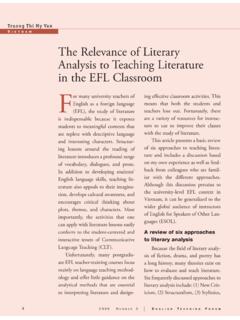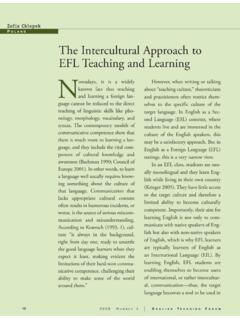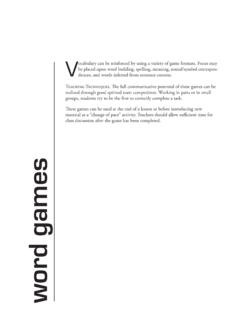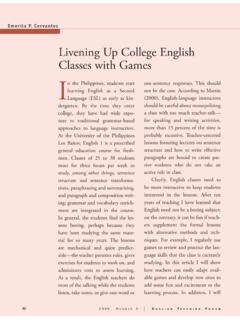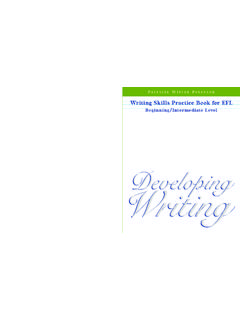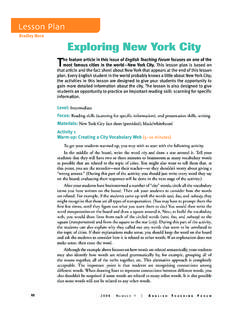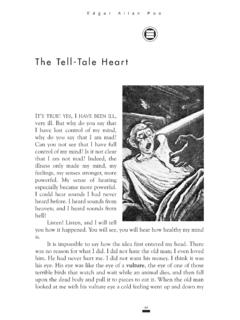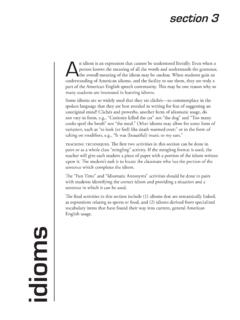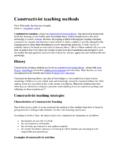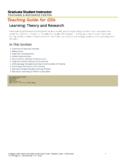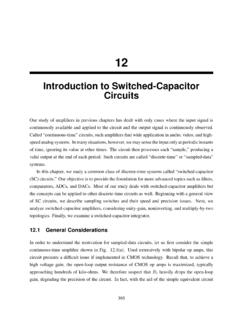Transcription of Language Teaching Methods - American English
1 LanguageTeachingMethodsTeacher s Handbook for the Video SeriesbyDianeLarsen-FreemanOffice of English Language ProgramsMaterials BranchUnited States Department of StateWashington, 205471990 Teacher s Handbook for the Video Series Language Teaching Methods by Diane Larsen Freeman Office of English Language Programs Materials Branch United States Department of State Washington, 20547 1990 PREFACE This video series featuring live demonstrations of current Methods of Teaching English as a second Language has been produced in the USIA WORLDNET studios in Washington, D,C. The Teaching materials which form the basis for these six unrehearsed classroom lessons were created by Prof.
2 Diane Larsen Freeman of the School for International Training (SIT) in Brattleboro, Vermont and appear in her book Techniques and Principles in Language Teaching (Oxford 1986). The six studio instructors, each a specialist in the method/approach being demonstrated, are staff members from Prof. Larsen Freeman s MA Program for Teacher Education at SIT: Michael Jerald (Audio Lingual Method); Bonnie Mennell (Community Language Learning); Kathleen Graves (Total Physical Response/Comprehension Approach); Lisa Sparrow (Suggestopedia); Donald Freeman (Silent Way); Alex Silverman (Communicative Approach). As you view the scenes representative of the various methodologies, you will notice that the teachers use a number of practical, tried and true techniques that can actually be applied in classrooms around the world, no matter what methodology is being followed.
3 Consideration of why/why not the techniques may be help ful for you should generate much thoughtful discussion in your workshop sessions. As Prof. Larsen Freeman has urged, keep an open mind and select those ideas that may be useful for your own Teaching purposes. In this accompanying Teacher s Handbook, you will note that each of the six units contains the video tran script of the author/director s commentaries, the demonstrator s lesson plans, suggestions for workshop activ ities, and additional classroom Teaching techniques (Extension of the Demonstration Lesson: Interactive/Communicative Activities). This appended material contains a wealth of innovative but practical ideas that may be used effectively with large or small groups, quite apart from the video activities or method ology.
4 On a personal note, the English Language Programs Division staff members who assisted during the video taping of this series found the experience altogether exciting and inspiring. First of all, the 45 international students (who gamely volunteered to be part of the studio classes) represent over a dozen countries, cultures, and linguistic backgrounds from around the world. As you will see, the studio cameras capture a multitude of responses and expressions on their faces evidence of total involvement in the innovative pair work and group activities. They seemed totally relaxed (for the most part! and thoroughly enjoying themselves; this, too, is dramatically visible through the eye of the camera.)
5 We believe that much of the secret to this effective Teaching /learning is due to the fact that the instructors make every effort to avoid being threatening or confrontative, and every effort to be encouraging and rein forcing. They, too, reported that the studio sessions were a great experience for them. We hope you will enjoy them as well and find new inspiration for your own Teaching . Anna Maria Malko Chief, Materials Branch TABLE OF CONTENTS Language Teaching Methods VIDEO ONE: Introduction [Diane Larsen Freeman] .. 1 I. AUDIO LINGUAL METHOD: Introduction [Larsen Freeman] .. 2 AUDIO LINGUAL METHOD: Materials [Michael Jerald].
6 3 Video Demonstration Lesson Plan .. 3 Teacher Training Discussion Questions .. 4 Teacher Training Activities .. 5 Extensions of the Demonstration Lesson .. 6 II. COMMUNITY Language LEARNING: Introduction [Larsen Freeman] .. 9 COMMUNITY Language LEARNING: Materials [Bonnie Mennell] .. 11 Video Demonstration Lesson Plan .. 11 Teacher Training Discussion Questions .. 12 Teacher Training Activities .. 13 Extensions of the Demonstration Lesson .. 14 III. COMPREHENSION APPROACH/TPR: Introduction [Larsen Freeman] .. 18 COMPREHENSION APPROACH/TPR: Materials [Kathleen Graves] .. 20 Video Demonstration Lesson Plan .. 20 Teacher Training Discussion Questions.
7 22 Teacher Training Activities .. 22 Extensions of the Demonstration Lesson .. 23 Language Teaching Methods VIDEO TWO: Introduction [Diane Larsen Freeman] .. 25 IV. SUGGESTOPEDIA: Introduction [Larsen Freeman] .. 26 SUGGESTOPEDIA: Materials [Lisa Sparrow] .. 27 Video Demonstration Lesson Plan .. 27 Teacher Training Discussion Questions .. 29 Teacher Training Activities .. 29 Extensions of the Demonstration Lesson .. 30 V. SILENT WAY: Introduction [Larsen Freeman] .. 32 SILENT WAY: Materials [Donald Freeman] .. 34 Video Demonstration Lesson Plan .. 34 Teacher Training Discussion Questions .. 37 Teacher Training Activities.
8 37 Extensions of the Demonstration Lesson .. 39 APPROACH: Introduction [Larsen Freeman] .. 41 COMMUNICATIVE APPROACH: Materials [Alex Silverman] .. 43 Video Demonstration Lesson Plan .. 43 Teacher Training Discussion Questions .. 45 Teacher Training Activities .. 46 Extensions of the Demonstration Lesson .. 47 VII. VIDEO TRANSCRIPTS .. 51 Audio-Lingual Method .. 52 Community Language Learning .. 53 Comprehension Approach .. 54 Suggestopedia .. 57 Silent Way .. 58 Communicative Approach .. 59 Language Teaching Methods : VIDEO ONEV ideo Introduction:Hello! My name is Diane Larsen-Freeman. I m a teacher educator at the School forInternational is common in Language teacher education programs to survey current Language Teaching SIT, we do this by giving our teacher trainees a direct experience with each method.
9 The purpose of thisvideotape series is to provide you with a similar, though vicarious, experience involving six common meth-ods: theAudio-Lingual Method,Community Language Learning, theComprehension Approach[on VideoOne],Suggestopedia, theSilent Way, and theCommunicative Approach[on Video Two].The intermediate-level lessons you will observe were taped at theWORLDNET television studios of the USIAin Washington, and it is through the courtesy of the USIA that this program is being made available toyou. The students were all volunteers who were studying English at the time. The instructors are experiencedlanguage teachers and teacher educators from SIT who have each taught students in various parts of theworld, using the Methods they will demonstrate for you the sake of coherence, the instructors have designed their lessons around a common theme namely,that of a house.
10 What you will see are somewhat condensed versions of the original lessons. All of the stepsof the lesson have been preserved, but some of the participation has been trimmed in the interest of instructors have tried to faithfully depict each method but, of course, each instructor is also putting theprinciples into practice based upon his or her interpretation and will introduce each method. Next you will observe the method in practice. Afterwards, I will point out someof the salient principles and techniques associated with each method. The lessons are meant only to intro-duce you to these Methods . All of the Methods have a richer repertoire of principles and techniques than canbe fully portrayed here.
